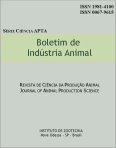Comparison between the chemical and the rubber - ring processes on Iambs castration
Abstract
Two methods of castration of lambs were compared, by rubber ring and chemical, in 1981 and 1985, in two regions: in the Posto de Ovinos e Caprinos de Itapetininga and in the Estação Experimental Central de Nova Odessa, both from the instituto de Zootecnia, State of So Paulo, Brazil. Thirty males were utilized in Itapetininga and 27 in Nova Odessa distributed in a completely randomized design to each region. The parameters studied were the following: retal temperature, weight gain, ambiental temperature and hematological values. The statistical analyses showed that retal temperature was different among the treatments in the second day in both regions, and in the third day in Itapetininga. This increase in the temperature was higher in the animals that suffered the chemical castration. The castration treatments did not affect the mortality level of the piglets. At the end of the experimental period it was taken blood samples to quantify the erythrocytes (mm3), leucocytes (mm3) and to measure the hematocrit value. The results of statistical analyses showed no significance between any hematic characteristic. The results of chemical and rubber ring castration of lambs suggest their employment in these animals.Downloads
Downloads
Published
Issue
Section
License
Os autores não serão remunerados pela publicação de trabalhos, pois devem abrir mão de seus direitos autorais em favor deste periódico. Por outro lado, os autores ficam autorizados a publicar seus artigos, simultaneamente, em repositórios da instituição de sua origem, desde que citada a fonte da publicação original seja Boletim de Indústria Animal. A revista se reserva o direito de efetuar, nos originais, alterações de ordem normativa, ortográfica e gramatical, com vistas a manter o padrão culto da língua e a credibilidade do veículo. Respeitará, no entanto, o estilo de escrever dos autores. Alterações, correções ou sugestões de ordem conceitual serão encaminhadas aos autores, quando necessário. Nesses casos, os artigos, depois de adequados, deverão ser submetidos a nova apreciação. As opiniões emitidas pelos autores dos artigos são de sua exclusiva responsabilidade. Todo o conteúdo deste periódico, exceto onde está identificado, está licenciado sob a Licença Creative Commons Attribution (CC-BY-NC). A condição BY implica que os licenciados podem copiar, distribuir, exibir e executar a obra e fazer trabalhos derivados com base em que só se dão o autor ou licenciante os créditos na forma especificada por estes. A cláusula NC significa que os licenciados podem copiar, distribuir, exibir e executar a obra e fazer trabalhos derivados com base apenas para fins não comerciais.













